MARIANI’SVirtual
Gourmet
AUGUST
17, 2014
NEWSLETTER
HOME
| BOOKS
| ABOUT US
| CONTACT

IN THIS ISSUE
NOW'S THE BEST TIME TO VISIT NANTUCKET
PART ONE
By John Mariani
WHAT IS BON APPETIT MAGAZINE TRYING TO SELL US?
By John Mariani
NEW YORK CORNER
REGENCY BAR & GRILL
By John Mariani
NOTES FROM THE WINE CELLAR
WHAT I'M DRINKING THIS SUMMER
By John Mariani
❖❖❖
NOW'S THE BEST TIME
TO VISIT NANTUCKET
Part One
By John Mariani
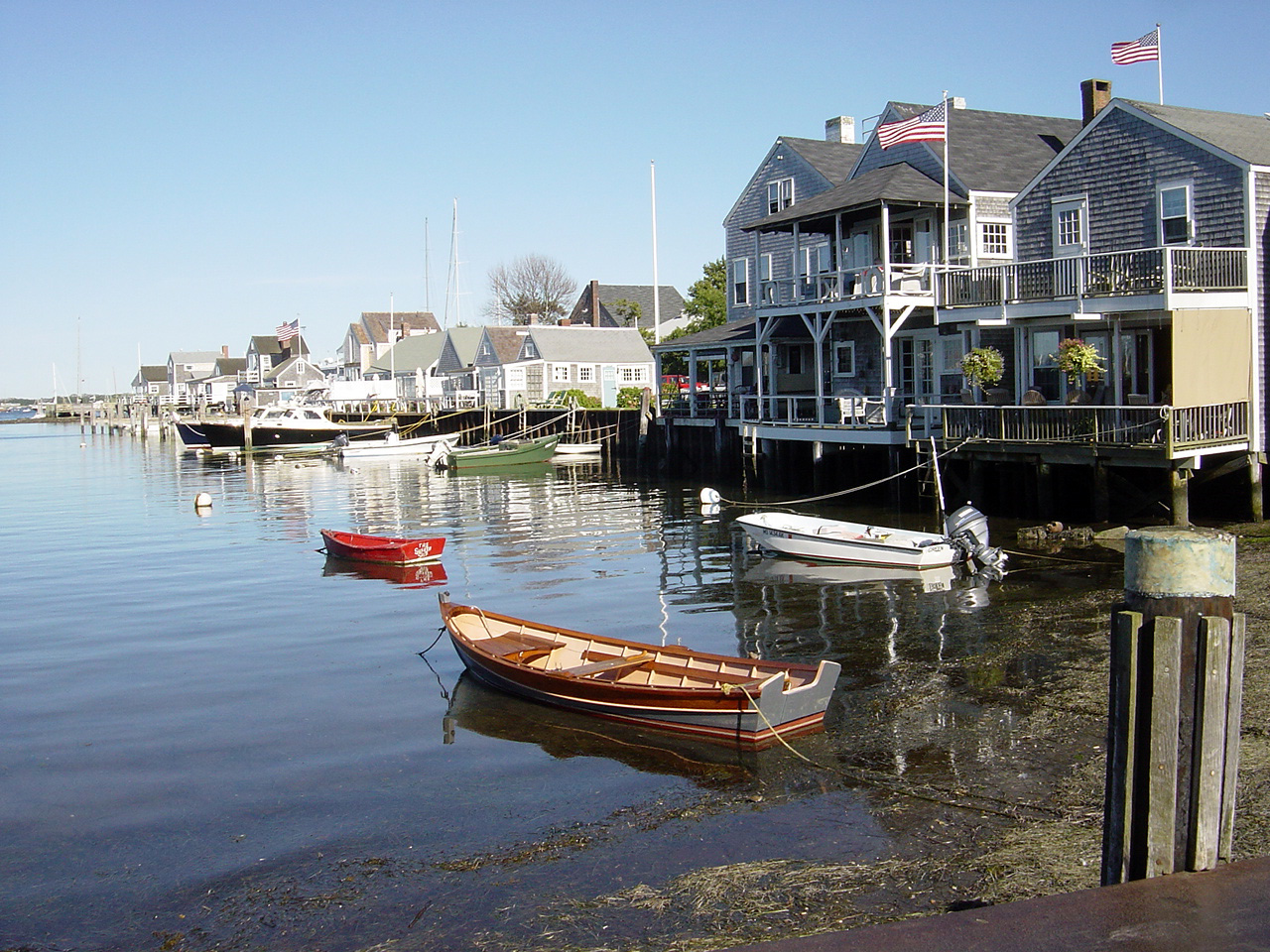
“Ant-hill in
the sea,” Herman Melville called it.
“A mere
hillock, and elbow of sand ... Some gamesome wights
will tell you that they have to plant weeds there
... That pieces of wood in Nantucket are carried
about like bits of the true cross in Rome; that
people there plant toadstools before their houses,
to get under the shade in summer time; that one
blade of grass makes an oasis, three blades in a
day's walk a prairie.”
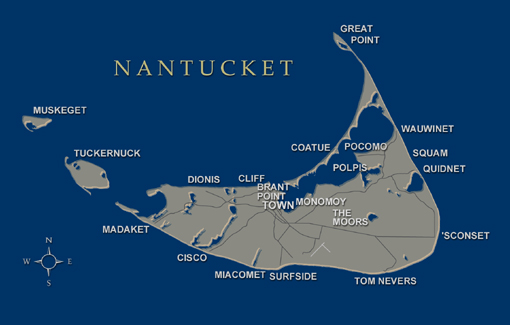 That was back in 1851.
Times have certainly changed. For, despite
very strict landmark and preservation commissions
that dictate the shape, colors and shingles of all
structures and prohibit national chains from opening
downtown (though somehow a Ralph Lauren boutique
slipped in), Nantucket was planted and landscaped a
long time ago. In summer it can be as crowded
as Disneyland; in winter, as dreary as
Lapland.
That was back in 1851.
Times have certainly changed. For, despite
very strict landmark and preservation commissions
that dictate the shape, colors and shingles of all
structures and prohibit national chains from opening
downtown (though somehow a Ralph Lauren boutique
slipped in), Nantucket was planted and landscaped a
long time ago. In summer it can be as crowded
as Disneyland; in winter, as dreary as
Lapland.
The best time to go is
from now until November (when many hotels and
restaurants close). The tourist season is still high
right now, but those one-time visitors and
day-trippers have slackened off.
Given the fact that
Nantucket is both difficult and expensive to get to
and because everything on the island is shipped in,
this is a pricey destination, and as such, the
entrepreneurs and restaurateurs have to make their
money fast and in volume. As one told me, “During
the season every night is Saturday night for us.”
The most
splendid resort outside of the congested downtown is
The Wauwinet Inn,
in its present form for 26 years, but with a history
as an inn since 1875, named after a local Indian
chief, this at a time when the steamship fare was 50
cents and a shore dinner 75 cents. Today owned
by the Karp family, The Wauwinet is, if preciously
so, the epitome of New England island elegance. And
the restaurant here, Toppers (right),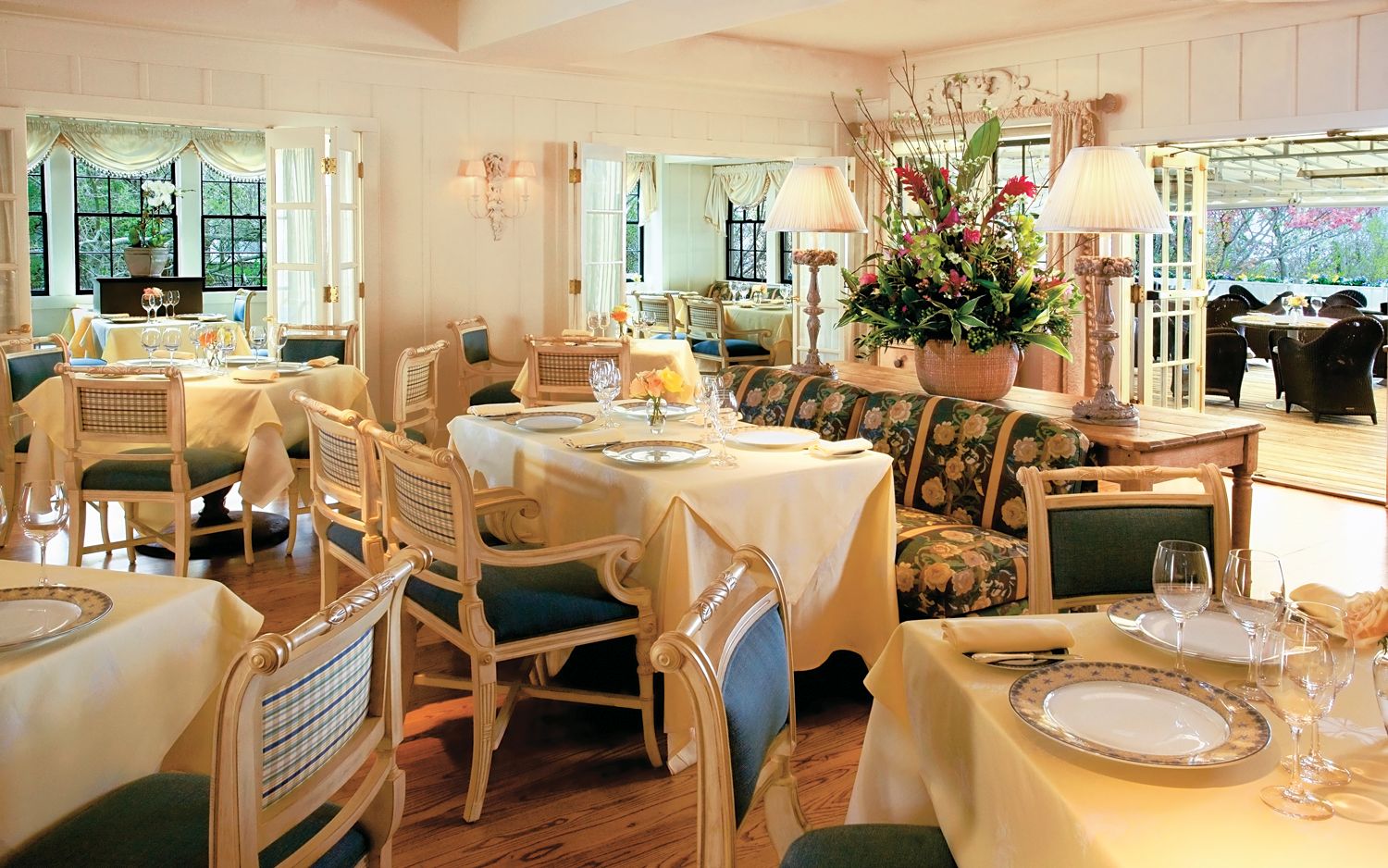 claims a consistent spot
on everyone’s list of favorites.
claims a consistent spot
on everyone’s list of favorites.
Although they
were serving a Sunday “Bubble Brunch” at Toppers, I
was able to avoid the clichés of that
in-between meal by going straight for the tart
flambé ($17) slathered with
crème fraîche and piled with sweet
onions, crisp lardons of bacon and a bubbly layer of
Gruyère on a fine pastry crust. Also
delicious was the Wauwinet turkey hash ($19), an
abundance of poultry meat with two eggs, mushrooms,
peppers, red bliss potatoes, a rich chicken
velouté and caramelized onions.
I could hardly
resist trying the lobster roll ($28) on a brioche
bun with Boston Bibb lettuce, pickles and the
delectable addition of a brown butter mayo (below) that
made it just different enough from most others.
Hand-cut French fries were crisp and greaseless
beside the lobster roll. Indeed, frying seems
a bonafide virtue in this kitchen, for its fish and
chips was so good I asked for the recipe.
Start with great fish, it’s tough to fail.
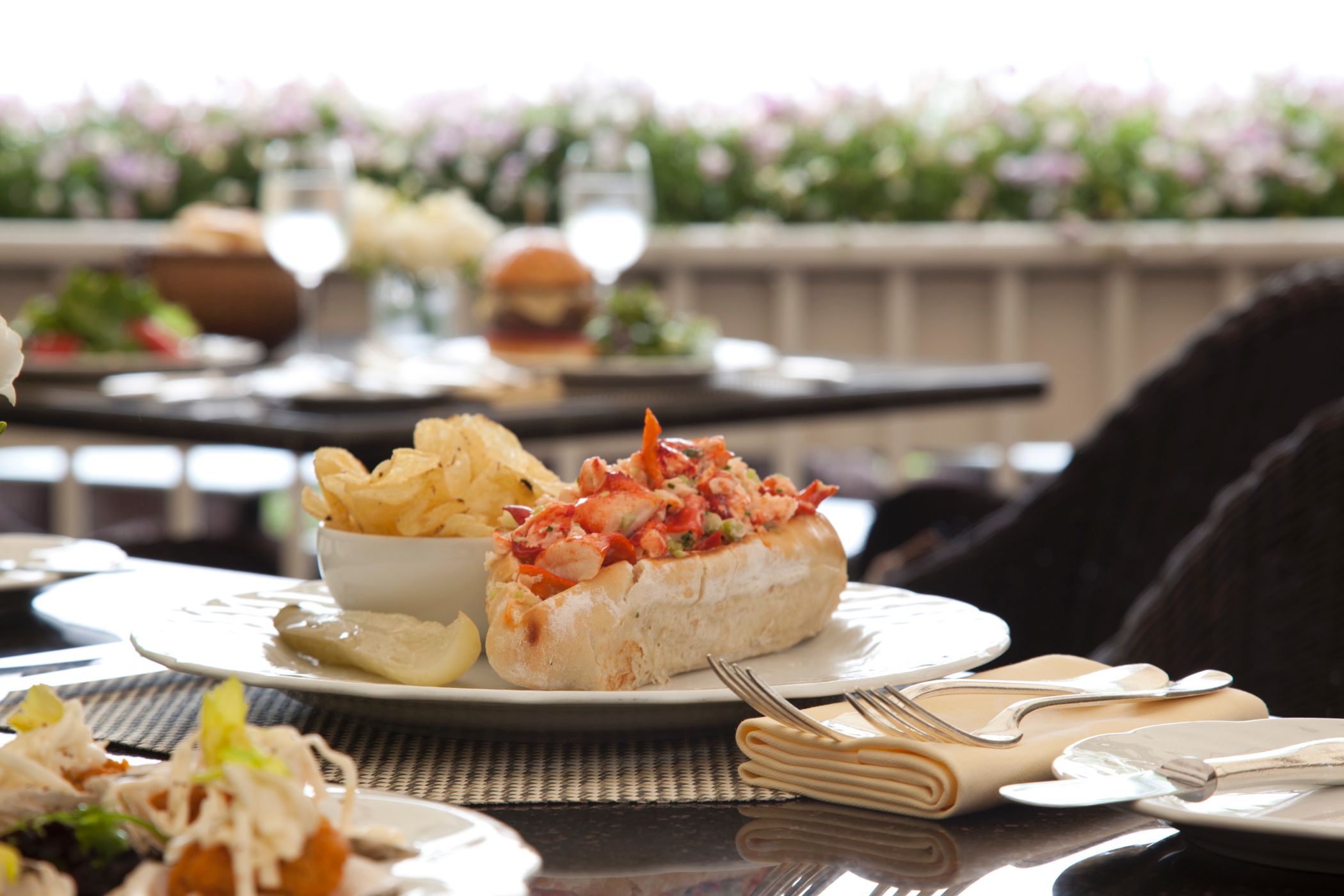 With a glass of Corton
Rognet 2005 and a breeze off the water, life
was very good that afternoon. The Wauwinet, by
the way, has one of the finest wine lists in the
nation to go with Chef Kyle Zachary’s American menu.
With a glass of Corton
Rognet 2005 and a breeze off the water, life
was very good that afternoon. The Wauwinet, by
the way, has one of the finest wine lists in the
nation to go with Chef Kyle Zachary’s American menu.
And for
dessert--though they are part of the brunch
starters--have the cinnamon sugared churros fritters
($10) with a dark chocolate sauce. Then
linger.
The Wauwinet is located at 120 Wauwinet Rd; 508-228-8768. Breakfast, lunch and dinner daily. Sunday brunch.
.
Oddly enough, it’s tough to
find really good restaurants on the Nantucket
seaside, but Cru
(below) is
easily the best. It’s always jammed and
managing partner Jane Stoddard is always there to
direct an amiable crew on how best to appeal to a
casual, hungry crowd willing to splurge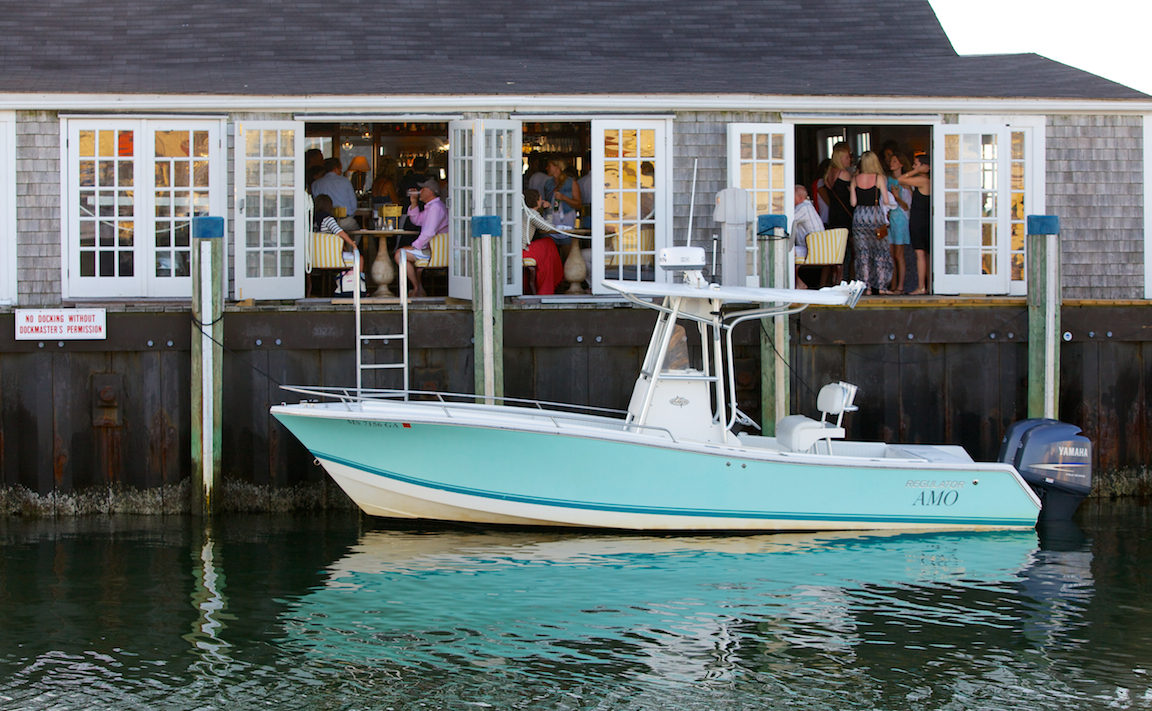 on a bottle
of Champagne.
on a bottle
of Champagne.
You can dine
inside or out, but the sea will always be within
view and you’re surrounded by worn docks, bobbing
boats and colored sails, so you get the
quintessential Nantucket experience at Cru.
That is, except for the pounding music they play in
the restaurant unnecessarily.
I had an
outstanding lunch here, via Chef Erin Zircher,
beginning with devilishly good hush puppies ($7)
with a tender pâte choux pastry. There
are also at least a half dozen species of oysters.
Seafood salad ($20) was as fresh and sunny as the
sea itself (below),
a smoked fish dip comes with cucumber, radish and
grilled focaccia ($14), and fried Ipswich clams
($24) with a Meyer lemon tartar sauce are kept
creamy in texture and crisp on the outside.
Sea scallops and white anchovy ($26) with chickpeas
and chickpea panissa
logs with red peppers and green beans manifests a
kitchen dedicated to pristine freshness.
Cru serves its
lobster roll ($28) cold, which is the way a lot of New
Englanders like it, so who am I to argue about such
a huge amount of lobster packed into a good
roll? If I like mine warm, so be it.
I finished off
with a finely textured Key lime pie in a jar.
Cru is located at 1 Straight Wharf; 508-228-9278; Open for lunch and dinner daily.
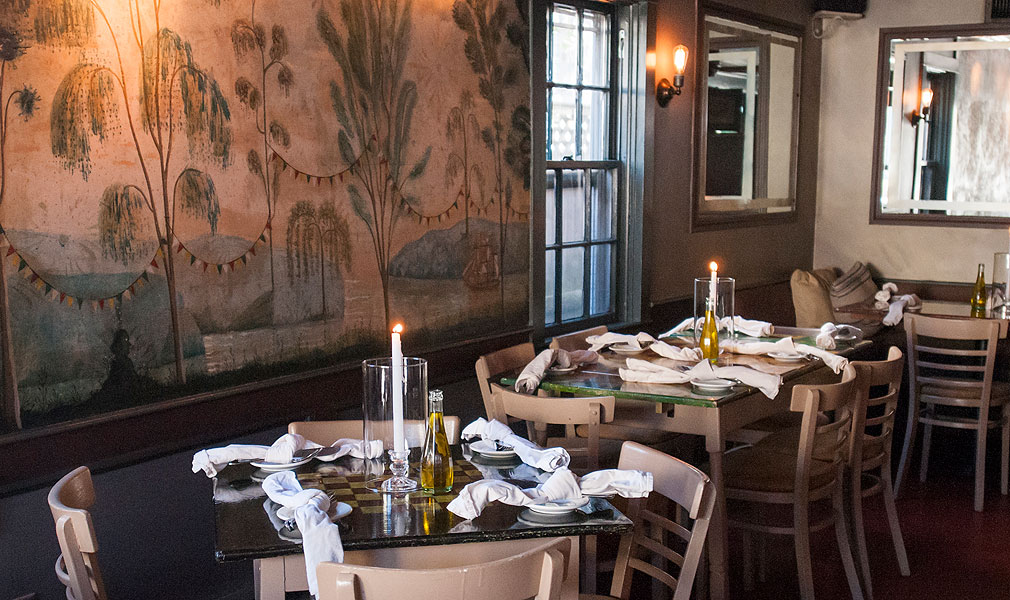 Possibly
the most evocative meal I had on a summer’s evening
was at the renowned American Seasons, (left) whose
dining rooms, both inside and out, pretty much nail
down the word “cozy” to a tee. But it’s a very
well wrought coziness, via lighting at its most
romantic, slatted ceiling, bare tables, candles in
wind funnels, and nature murals of more than a
little interest, as is the menu, which is definitely
not traditional Nantucket.
Possibly
the most evocative meal I had on a summer’s evening
was at the renowned American Seasons, (left) whose
dining rooms, both inside and out, pretty much nail
down the word “cozy” to a tee. But it’s a very
well wrought coziness, via lighting at its most
romantic, slatted ceiling, bare tables, candles in
wind funnels, and nature murals of more than a
little interest, as is the menu, which is definitely
not traditional Nantucket.
Chef Michael LaScola draws from many nations
for recipes, but they are always very much his own
ideas; his wife, Orla Murphy, oversees a 500-label
wine list of small producers.
I let myself be
guided by Orla’s recommendations and ate widely
across the menu, beginning with a fine chicken and
carrot terrine with lovely zucchini fritters and
tangy-sweet apricot slaw ($16.50). Spicy 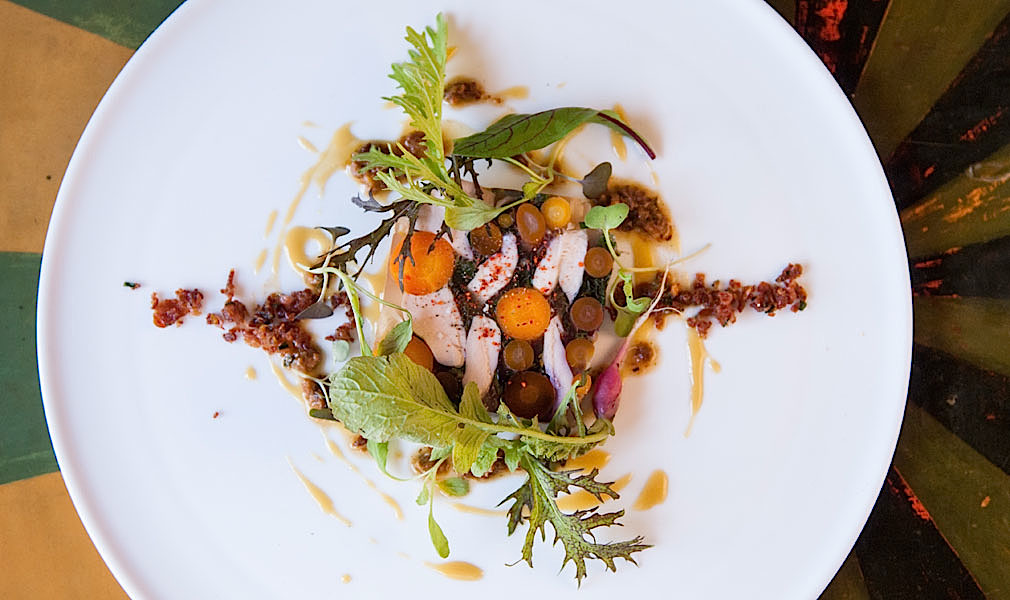 but not too hot kimchi
pancakes ( $16.50) made with succulent pork belly,
smoked shrimp and sesame dressing might have come
from the best Korean restaurant in Boston, while
tilefish---a species often in need of help to bring
it alive--got plenty of enhancement from smoked
tomato grits, bacon succotash and buttered corn
broth ($34).
but not too hot kimchi
pancakes ( $16.50) made with succulent pork belly,
smoked shrimp and sesame dressing might have come
from the best Korean restaurant in Boston, while
tilefish---a species often in need of help to bring
it alive--got plenty of enhancement from smoked
tomato grits, bacon succotash and buttered corn
broth ($34).
What distinguishes
all of Chef Michael's food is an exceptional
attention to contrasting flavors and, especially,
textures, so you always get a taste of salty and
savory, briny and tangy, along with crispiness and
spark. Portions are also very generous.
The crowd, by the
way, knows precisely what is meant by the owners’
request for “casual, proper attire -- No jackets or
ties required.” This is not a place to play the
beach bum.
American
Seasons
is located at 80 Center St; 508-228-7111. Dinner
nightly.
❖❖❖
WHAT IS BON APPÉTIT MAGAZINE
TRYING TO SELL US?
By John Mariani

Is this a Bon Appetit food critic?
The announcement of the 50 nominees for the best restaurants of 2014 in Bon Appétit magazine is, not for the first time, cause for gourmets, gastronomes, connoisseurs and foodies to scratch their heads in wondering what the magazine is trying to tell--or sell--us about the state of dining out in America. And what it tells us is that, unless yours is a restaurant that is very edgy, cheaply decorated in worn-out clichés, often highly uncomfortable, and largely ego driven, you haven’t a chance of getting onto such a list.
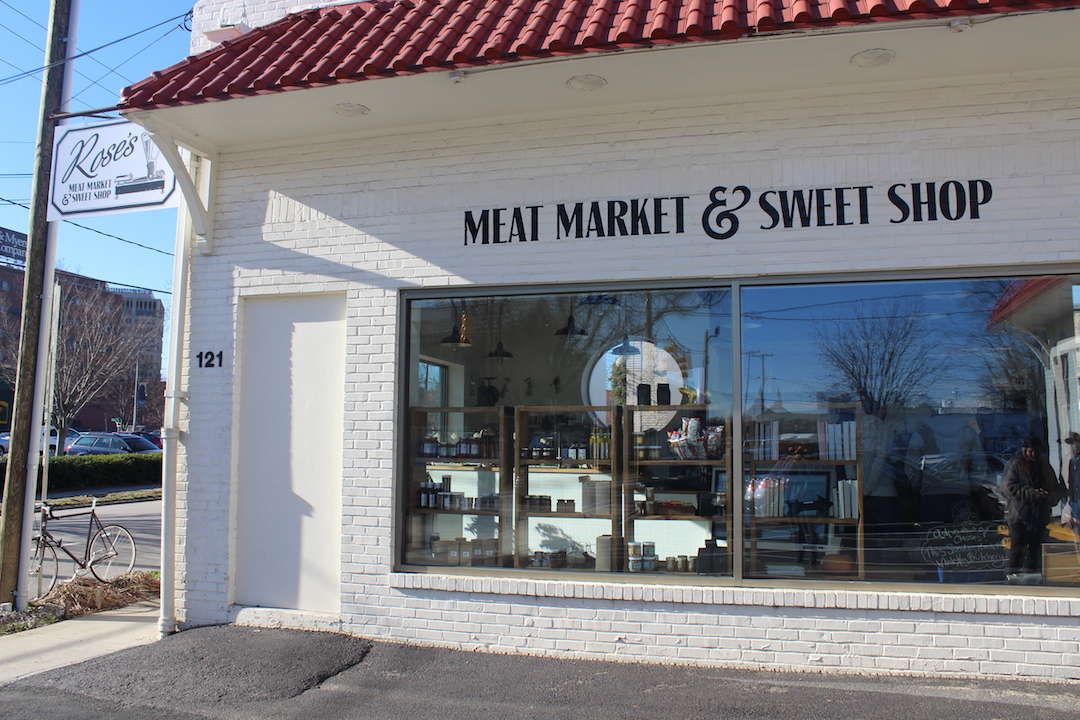 Now, let me say straight
away and loudly--and I will repeat this throughout
this article: I am in no way criticizing the food in
these restaurants, largely because I have not eaten
in every one. I have, however, dined in many
of them, lavished praise on several, and put some of
these same restos on my own list of Esquire’s Best
New Restaurants in America.
Now, let me say straight
away and loudly--and I will repeat this throughout
this article: I am in no way criticizing the food in
these restaurants, largely because I have not eaten
in every one. I have, however, dined in many
of them, lavished praise on several, and put some of
these same restos on my own list of Esquire’s Best
New Restaurants in America.No one has more respect than I do for the hard work and creativity that goes into opening and maintaining a restaurant in America these days. Nor am I questioning the taste of the Bon Appétit writers who searched far and wide, at some expense, for their nominees.
What I am questioning is what clearly appears to be an attitude problem here, one that glorifies novelty, youth, eccentricity and hipsterism for their own sake, while ignoring the excellence of those veteran restaurateurs who still believe in setting a good table, offering unique design and décor--often to the tune of millions of dollars--pouring significant capital into an enduring wine list of depth and breadth, hiring a chef who deserves to be paid top dollar for his experience and ability to run a professional kitchen, a service staff that sees to every aspect of their clientele’s comfort, then charges a fair price for the quality level of the entire dining experience.
Walk into any of BA’s nominated restos and you won’t find any décor by Adam Tihany or David Rockwell. In most you won’t find widely separated tables--forget entirely about now anathema tablecloths!--or fine china and silverware. You won’t find a pleasingly dressed wait staff. Instead, you will find a banality of design clichés--exposed brick and duct work, hanging exposed light bulbs, antique tiles, salvaged wood,
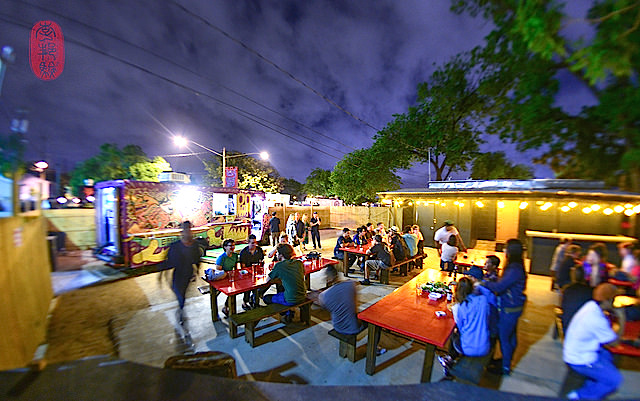 old counter
stools--that were new-ish ideas a decade ago.
You’ll find cramped quarters, diner counters with
backless stools that don't spin, ear-splitting
noise, crappy music, hour-long waits,
no-reservations policies, a wine stock made to last
no more than a month, and a staff, however amiable,
wearing whatever they felt like that morning.
And that's
what you're paying top dollar for.
old counter
stools--that were new-ish ideas a decade ago.
You’ll find cramped quarters, diner counters with
backless stools that don't spin, ear-splitting
noise, crappy music, hour-long waits,
no-reservations policies, a wine stock made to last
no more than a month, and a staff, however amiable,
wearing whatever they felt like that morning.
And that's
what you're paying top dollar for.The argument goes that one shouldn’t care about any of that if the food is "freaking" good. And, again: I am in no way criticizing the food in these restaurants, although, perusing many of the menus from the list, I have to wonder if those with three items as main courses, one of them a salad, another a hamburger, really rise to the ideal of “best.” Maurice in Portland, OR, is a bakeshop and luncheonette; Thai-Kun (right) in Austin is a food court; Palace Diner (below) is, well, a diner; Rose’s Meat Market & Sweet Shop (above) in Durham, NC, is a sandwich spot--“not actually a restaurant,” says BA--The London Plane in Seattle is a grocery with lunch items. Do these really qualify as candidates for the best restaurants of 2014?
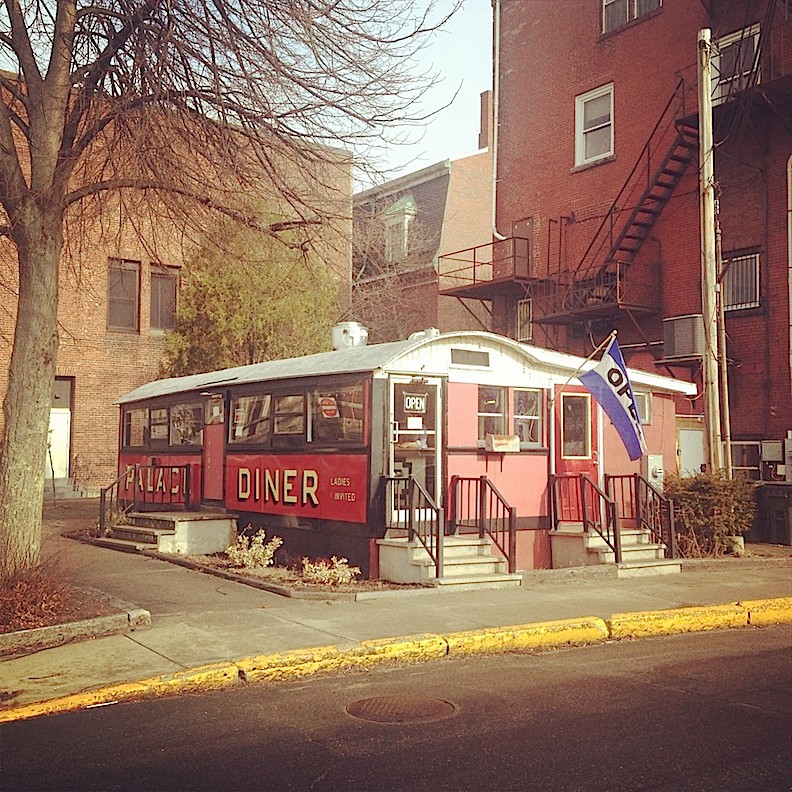 Yet
you’ll pay as much or only slightly less for the
food at these places as you would at a restaurant
that spent heavily on décor, staff, kitchen
and amenities, often in very high-rent
neighborhoods. For instance, BA’s choice
of Coltivare Pizza &
Garden in Houston (which takes no
reservations) charges $30 for pork with creamer
peas, corn, tomato broth and peaches. Odd Duck in
Austin charges $41 for lamb shoulder with chickpeas,
yogurt and naan.
At High Street Market
in Philadelphia, with its coffee shop booths and
backless stools, you’ll pay $22 for tortelloni with
asparagus, guanciale
and vegetable ragôut.
The $10 dessert is now ubiquitous.
Yet
you’ll pay as much or only slightly less for the
food at these places as you would at a restaurant
that spent heavily on décor, staff, kitchen
and amenities, often in very high-rent
neighborhoods. For instance, BA’s choice
of Coltivare Pizza &
Garden in Houston (which takes no
reservations) charges $30 for pork with creamer
peas, corn, tomato broth and peaches. Odd Duck in
Austin charges $41 for lamb shoulder with chickpeas,
yogurt and naan.
At High Street Market
in Philadelphia, with its coffee shop booths and
backless stools, you’ll pay $22 for tortelloni with
asparagus, guanciale
and vegetable ragôut.
The $10 dessert is now ubiquitous. These prices are high, and included in them may be cheap wine glasses or Mason jars, paper napkins, tin ware, mismatched china, Formica tabletops, dime store salt and pepper shakers, a single washroom for both sexes, and nothing to buffer the noise. Quaint and casual shouldn't cost so damn much.
Yet the same people who rave over High Street Market's $22 tortelloni balk at paying $25 for the tortelloni with robiola, mascarpone, asparagus and basil at the very elegant Ristorante Morini in NYC, or the risotto with imported scallops, shrimp, lobster, clams, cuttlefish and octopus for $24 while lounging in a cabana at the very posh Bartolotta in Las Vegas (below). These large restaurants, by the way, are as jammed as any on BA’s list of places with six stools.
What BA is pushing is an agenda that insists fine dining is either dead, no fun or simply transformed into anything at all as long as it
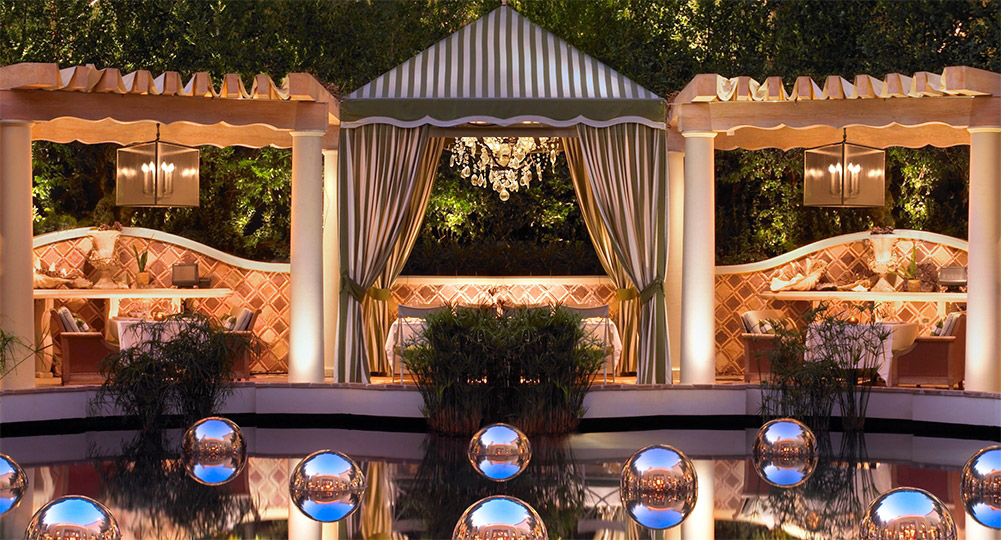 tastes
"freaking" good. One has to wonder if the words
“fine,” “refinement” and “exquisite” mean more to BA’s writers
than their overuse of worn-out phrases like “really
tasty,” “seriously delicious,” “outrageously
delicious,” “heavy on indulgence, luxury, and--of
course--deliciousness,” “the whole experience is a
trip,” “beyond satisfying,” “as right now as it
gets,” “couldn't feel more of the moment,” “awesome
cocktails,” “watch the chefs do their thing” and
“manages to marry sophisticated techniques with a
dorm-room stoner's idea of flat-out
deliciousness.” They sound like what you might
have read in The
Village Voice
back in 1968.
tastes
"freaking" good. One has to wonder if the words
“fine,” “refinement” and “exquisite” mean more to BA’s writers
than their overuse of worn-out phrases like “really
tasty,” “seriously delicious,” “outrageously
delicious,” “heavy on indulgence, luxury, and--of
course--deliciousness,” “the whole experience is a
trip,” “beyond satisfying,” “as right now as it
gets,” “couldn't feel more of the moment,” “awesome
cocktails,” “watch the chefs do their thing” and
“manages to marry sophisticated techniques with a
dorm-room stoner's idea of flat-out
deliciousness.” They sound like what you might
have read in The
Village Voice
back in 1968.Such hipster prose is hardly surprising since, as the director of one city’s tourist board told me, “The Bon Appetit writer who came to town told me he didn't want to eat anywhere the chef didn’t have tattoos.” I don't think he was kidding. Indeed, it appears that if a restaurant has any pretensions at all to elegance, subtlety, refined and beautiful design, an experienced staff and a great wine list, BA has next to no interest in it. Where are superb new restaurants like NYC’s Bâtard, Rôtisserie Georgette and Beautique (below), where the staff is in designer outfits, the china is by Vera Wang and the seat fabrics by Jean-Paul Gaultier? Fiola Mare in DC, which has a glass wall and verandah over the Potomac, gorgeous marble bar, roomy banquettes, and tufted, turning stools with backs? Marti’s in New Orleans, with its historic murals, swag curtains and exquisite chandeliers? St. Cecilia in Atlanta, with soaring ceilings, gorgeous leather booths, and first-rate wine list? They likely were not considered because they don’t fit the funky cool mold. Even "casual chic" has become a suspect term. True, you can't eat the furniture but dining in such places is not an ordeal and you pay accordingly for the fine cuisine and decor, as you would for a Zegna suit or Ferragamo loafers. The BA restaurants are more the equivalent of $300 blue jeans.
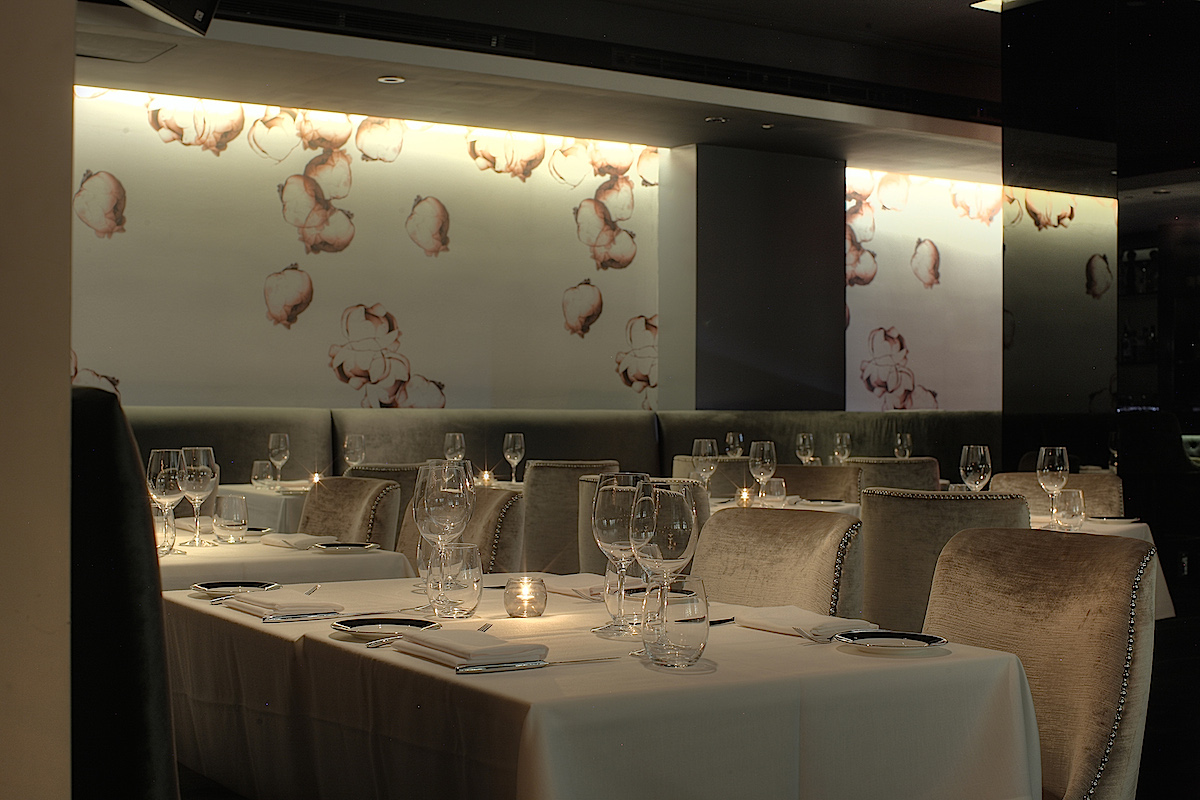 Also
surprising is that so many of Bon Appetit’s
candidates for Best New Restaurants of 2014 actually
opened way
more than a year ago, including Serpico in
Philadelphia, Trois
Mec in L.A., Sir and Star in Olema, CA, Uncle Boons in
NYC, Ribelle
in Brookline, MA, Gunshow
in Atlanta, and others. So, why they are
being considered for 2014 is a puzzle?
Also
surprising is that so many of Bon Appetit’s
candidates for Best New Restaurants of 2014 actually
opened way
more than a year ago, including Serpico in
Philadelphia, Trois
Mec in L.A., Sir and Star in Olema, CA, Uncle Boons in
NYC, Ribelle
in Brookline, MA, Gunshow
in Atlanta, and others. So, why they are
being considered for 2014 is a puzzle? Once again: I am in no way criticizing the food in these restaurants. I applaud them all and hope you try them out. But the problem with BA’s list is that it is so lopsided. However seriously one wants to take the Michelin Guides or the controversial Restaurant magazine awards, the number of jam-packed, very high-end, highly creative, innovative and well designed dining rooms run by some of the great master chefs on the planet on those lists make it obvious that such restaurants are far from moribund and cannot be ignored, unless one’s purpose is to deny that they have anything to do with that empty phrase “the way we eat today,” which actually means, “the way our editors ate last month.” Apparently "we" does not include those people who pack restaurants like The French Laundry in Yountville, CA; Blue Hill at Stone Barns in Tarrytown, NY; Tony's in Houston; and Joël Robuchon in Las Vegas.
To consider for inclusion only restaurants--even those that are “not actually a restaurant”--with a hipster edge and to sniff at all else is like a theater critic reviewing only Off Broadway shows, a film critic only indie productions, a music critic only hip hop, or an automotive critic only compact cars. There’s plenty to love among such enterprises, but they are not the whole story of what goes on in those worlds.
Apparently, BA editors think only their restaurant choices are.
❖❖❖
By John Mariani
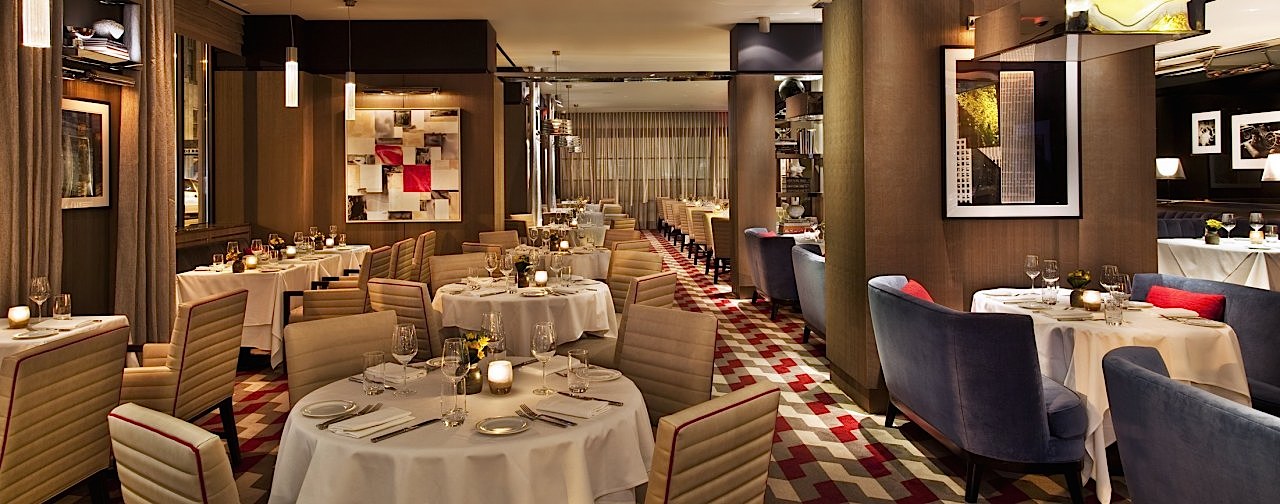
Loews Regency Hotel
540 Park Avenue (at 61st Street)
212-339-4050
regencybarandgrill.com
The re-opening of the
Loews Regency Bar & Grill is occasion to
applaud, but not
because it has now filled the void it left upon
closing for the Power Breakfast crowd that used to
fill it every weekday morning.
Time
being so valuable in an ever more hectic New York,
the Business Breakfast is still a way for
executives, media types and politicians to hobnob
over eggs ($23 for two) and a bagel ($7) and exit
quickly for the office (although some guys have two
breakfasts, back to back!). So, after fifty
years, during the closing and refurbishing of the
room, those regulars--some daily like Rev. Al
Sharpton, whose religious denomination apparently
requires no vow of poverty--had to find other
venues, and the East 60’s is an early morning
wasteland for breakfast.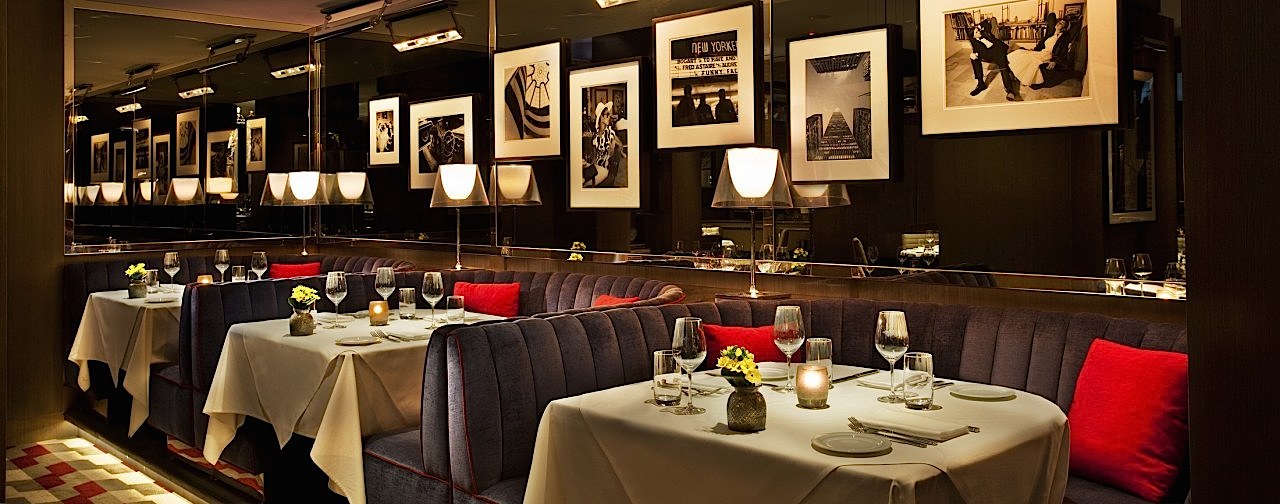
Now the
Bar & Grill is open again bright and early at 7
a.m. and packed as usual, which is nice to know.
What I am happiest about, however, is that at
lunch and dinner, Executive Chef Dan Silverman,
formerly at The Standard, has been given the
go-ahead to bring culinary luster to the room, whose
previous reputation made the “hotel dining room” a
slur term.
The place
looks better than ever, very sleek, with a vivacious
bar up front and a long, two-level dining room done in soft
executive dining room colors, with double
tablecloths, an Op Art rug, bookshelves and abstract
paintings. The booths (above), up one
slender step, are tough to squeak into but difficult
to leave, for they are among the most comfortable in
New York. The mirrored walls above them are hung
with black-and-white photos of Upper East Side
totems.
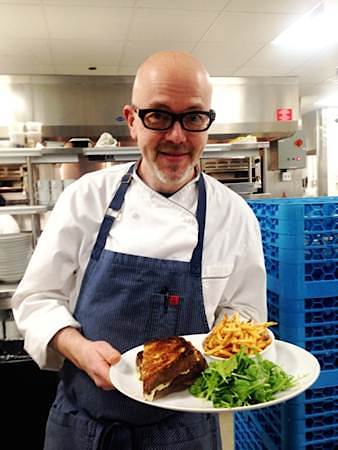 I was so
happy to see Wine Director André Compeyre,
formerly of Alain Ducasse’s Benoit Bistro,
overseeing a formidable list that’s been updated and
better priced, even offering some excellent New York
State wines usually ignored by New York City
restaurants.
I was so
happy to see Wine Director André Compeyre,
formerly of Alain Ducasse’s Benoit Bistro,
overseeing a formidable list that’s been updated and
better priced, even offering some excellent New York
State wines usually ignored by New York City
restaurants.
Silverman
(left) sets
a menu in line with the restaurant’s name, an
American grill seasonally focused. So, if the
soft shell crabs ($24), with a vegetable pistou, are
still on the menu, by all means enjoy them. I
ordered a tomato soup ($18) as a good indicator
whether this child’s lunch item could be transformed
into an adult pleasure, and Silverman did himself
proud. The soup tasted as if he’d squeezed
every drop of goodness from summer’s tomatoes and
cooked them up to taste like their very essence,
accompanying them--nice touch--with grilled cheese
crostini.
I tried
an outstanding pasta--tagliatelle with a veal ragù and large dose of Parmigiano ($28)
that would rank with the best Italian restaurants’
in the city.
Pan-roasted Dover sole ($65) is another telltale
dish, and the Grill’s version, plump and meaty, with Meyer
lemon, parsley and brown butter (a very, very
generous pool of it) was so rich you could share it
with another guest and be completely satisfied.
with Meyer
lemon, parsley and brown butter (a very, very
generous pool of it) was so rich you could share it
with another guest and be completely satisfied.
When
you’re talking about great ingredients like Dover
sole (right),
you are also talking about veal and lamb. Silverman
(left) gets
the former from Pennsylvania and his veal chop with
wild mushrooms and creamed spinach ($48) is
nonpareil. So, too, are the Colorado lamb
chops, served with Swiss chard and a crispy shank
($46), though the sauce with the dish was bland and
a bit muddy in color and texture. I think I’d
go with them simply grilled next time.
Pastry Chef Jeff Sytsma,
most recently of The Elm, stays within the American
crayon box with the signature Regency Chocolate Bar
(below),
composed of feuilletine crunch and dark chocolate
ganache topped with cocoa nib sorbet; good old
carrot cake is made new with a cream cheese mousse
and walnut crumble, accompanied by rum raisin ice
cream. Bring extra forks. And 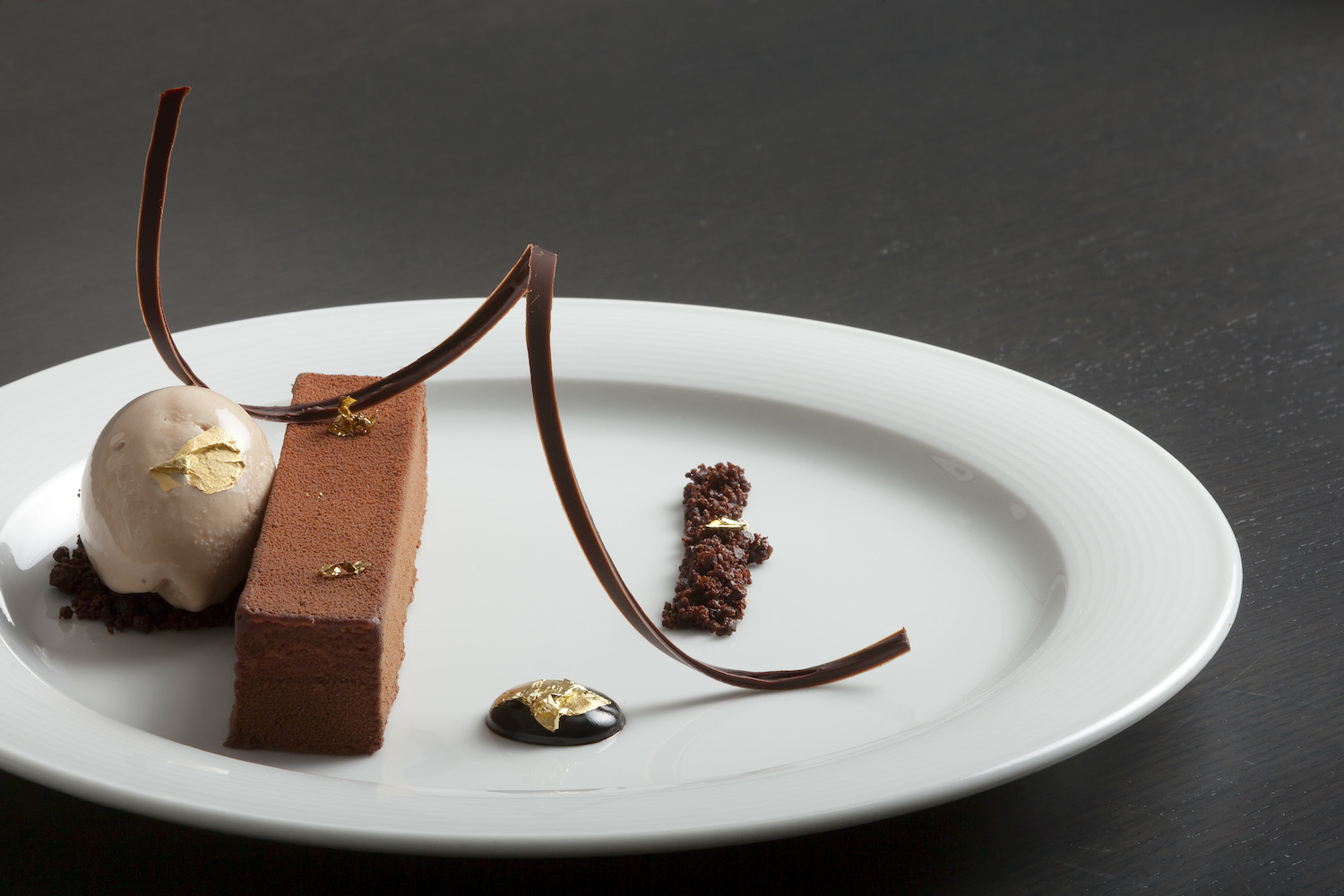 order the
cookie plate. All desserts are $12.
order the
cookie plate. All desserts are $12.
So, let the honchos claim their spot at breakfast. I’ll go back for the food and wine at dinner. One caveat, the major misfire at the restaurant when I visited two weeks ago was a slack staff that seemed far more interested in re-setting tables than paying attention to guests. But then, I’m not Reverend Al.
Breakfast: 7-11:30 a.m. Lunch: 11:30 a.m.-3:30 p.m. Afternoon tea: 3:30-5:30 p.m. Dinner: 5:30–11 p.m.
.
❖❖❖
 WHAT I'M DRINKING THIS SUMMER
WHAT I'M DRINKING THIS SUMMERBy John Mariani
2005 Domaine Chevalier Père et Fils Corton Rognet ($110) - For those who cannot bring themselves to lay out exorbitant money for a first-rate red Burgundy, this may be a more moderate option. The vineyard, near Aloxe-Corton and Corton Charlemagne, produces a wine with typical Burgundy finesse in a somewhat lighter style, and the 2005, if you can still find it, has evolved beautifully to a maturity that makes it a wonderful wine with poultry or game.
2011 Patrick Javillier ‘Les Tillets” Meursault ($50) - Most of this domaine’s wines
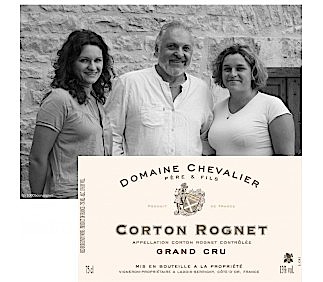 are
Chardonnay and Javillier is one of the finest
producers, a believer that longer
time on the lees produces more character, and this beauty can only get better
over the next five years. But its honeyed hints and its superb aromatics
make it well worth drinking right now with any seafood, not least one in
a rich butter-based French sauce. Les Tillets, by the way, refers to a
medieval lime tree.
are
Chardonnay and Javillier is one of the finest
producers, a believer that longer
time on the lees produces more character, and this beauty can only get better
over the next five years. But its honeyed hints and its superb aromatics
make it well worth drinking right now with any seafood, not least one in
a rich butter-based French sauce. Les Tillets, by the way, refers to a
medieval lime tree.2011 Benjamin Leroux Clos de la Cave des Ducs Volnay Premier Cru ($100) -Volnays are iffy wines from the Côte de Beaune, so it’s important to know the producer. Its reds are light in color, but this Premier Cru shows the wine at its best. The vineyard is managed biodynamically and the terroir of the small estate shows in its richness, power and mineral strength. It is still developing and should emerge in a couple of years as a grand expression of Volnay.
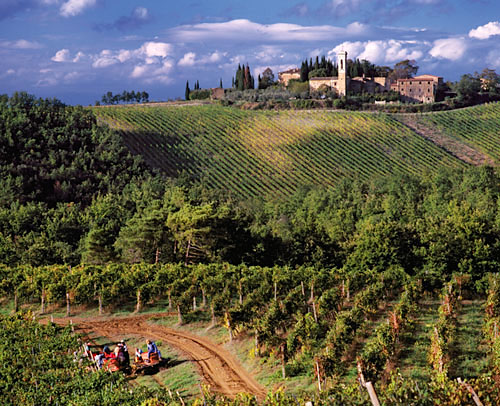 2012
Isole e Olena Collezione Privata Chardonnay
($38) - Not all Italian chardonnays hit the high notes of
Angelo Gaja’s masterpieces, but this far more modestly priced example gives a
lot of pleasure for the money. The name refers to two estates owned by
the De Marchi family in Tuscany, and, while better known for their Chiantis,
they produce this fine, lush white wine whose grapes receive a
great deal of sun and are harvested fairly late.
2012
Isole e Olena Collezione Privata Chardonnay
($38) - Not all Italian chardonnays hit the high notes of
Angelo Gaja’s masterpieces, but this far more modestly priced example gives a
lot of pleasure for the money. The name refers to two estates owned by
the De Marchi family in Tuscany, and, while better known for their Chiantis,
they produce this fine, lush white wine whose grapes receive a
great deal of sun and are harvested fairly late.2013 Franciscan Estate Napa Valley Sauvignon Blanc ($17-$20) - There are no more than a handful of California Sauvignon Blancs I care to drink because too many are cloyingly grassy and too floral. This fresh entry is, however, much closer to a crisp Sancerre while still showing off its bold California grip on the palate. No color to speak of, but the flavors are all arrayed in a charming balance of fruit and minerals. And the alcohol
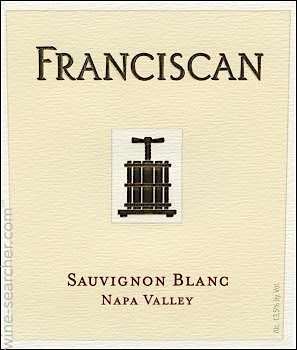 level at 13%
is totally sensible for a white wine.
level at 13%
is totally sensible for a white wine.2010 Williamsburg Winery Adagio ($72) - This price tag for a wine made in Virginia may put some people off, but it is a very good and very persuasive argument that the state’s wines now demand respect. This is a Bordeaux blend of 42% Cabernet Franc, 30% Merlot and 28% Petit Verdot--no Cabernet Sauvignon--yet it has enormous depth and complexity picked up from 18 months in oak, and the winery’s keeping the alcohol down to 13% is much to be applauded.

Physicist
Manuel Linares has created an ice cream that changes
color as you eat it, made from "entirely natural
ingredients."
WHY THERE'LL
ALWAYS BE AN IRELAND
Irishman Anto Wickham paid $5,000 to have a local
coffinmaker build him a ten-foot tall coffin in the
shape of a Jack Daniels bottle. The
designer says it was "very complicated" because "there
are so many curves in a Jack Daniels bottle and it is
almost cut like a diamond," but adds it's fine because
"there was no rush" on the craftsmanship. Wickham also
plans to be delivered to the gravesite in a Guinness
van.
The Man in
the Window
 by Cristina Mariani-May
by Cristina Mariani-May
co-CEO of Banfi Vintners
America's leading wine
importer
Christian Scrinzi know where he stands.
As head winemaker for the historic
wine house of Bolla, Scrinzi knows the stakes.
Leading producer of
Veronese wines and the ambassador for Italian wine
around the world, Bolla has a century and a quarter’s
worth of iconic imagery to uphold, and expectations to
meet.
of
Veronese wines and the ambassador for Italian wine
around the world, Bolla has a century and a quarter’s
worth of iconic imagery to uphold, and expectations to
meet.
“A winemaker for such a producer is
nothing more than a short window into that winery’s
history,” Scrinzi admits. “He must maintain and
uphold the standards of that house, be aware of its
past, and be conscious of its future. He must usher it
responsibly into that future.”
Value is what Bolla is known for, but it is also known
for innovation, quality, and making wines with a sense
of place.
Yes, there were years when
Bolla seemed to have lost its way and followed the
siren call of quantity over quality, but today Bolla
is back to its roots, literally and figuratively.
It no longer chases fashion and trends, and has
returned to the typicity of its native soil and
microclimate – a rich dichotomy of fresh young wines
such as Soave, Valpolicella and Bardolino, which speak
of tradition and ‘terroir,’ alongside the ultimate
sartorial wine, Amarone.
To make the wonderful wines of
Verona, Scrinzi has forged an alliance with Bolla’s
agronomist GianAntonio Marconi. Marconi is the
direct professional heir to Franco Bolla, the man who
forged strong relationships with the grape growing
families that have conferred their fruit to Bolla for
multiple generations. Even a “volume” producer
like Bolla must ensure quality from the ground up in
order to produce wines with a sense of identity and
integrity. It all begins in the vineyards, after
all.
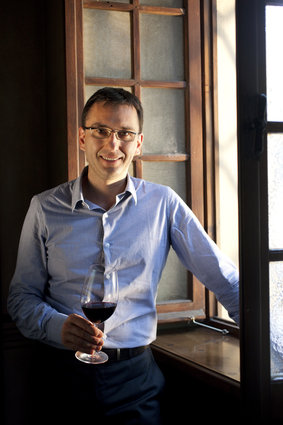 Historically,
Scrinzi
(left) looks
to Bolla’s origins, literally, with a wine called “Le
Origini,” an Amarone that harkens back to founder
Abele Bolla’s preference for the wine that was a
century ago unique and unusual as a “big” wine, made
rich from fruit that dried naturally in ventilated
attics called “fruttai.” Amarone is by now a
tradition that has succeeded and is a proving ground
for all Veronese producers, and Bolla interprets it in
its own inimitable way.
Historically,
Scrinzi
(left) looks
to Bolla’s origins, literally, with a wine called “Le
Origini,” an Amarone that harkens back to founder
Abele Bolla’s preference for the wine that was a
century ago unique and unusual as a “big” wine, made
rich from fruit that dried naturally in ventilated
attics called “fruttai.” Amarone is by now a
tradition that has succeeded and is a proving ground
for all Veronese producers, and Bolla interprets it in
its own inimitable way.
But Scrinzi did not limit himself
to the successes of the past; he chose to also examine
the “failures” of the past, as it were.
In
the 1980s, Verona had an inferiority complex.
Amarone was not very well known yet, and the “Super”
wines of Tuscany ruled the roost. Super Tuscans
were wines that combined Tuscany’s native Sangiovese
with the “international” (really French) varietals
such as Cabernet Sauvignon and Merlot. They met
with great success, and the Veronese wondered, “why
not me, too?”
So Bolla
created a wine called Creso. They
based it on Cabernet, with a small percentage of the
local grape, Corvina, to
give it needed acidity and a local touch.
It did well “back in the day,” but in fewer than ten
vintages the
novelty wore off, and Creso was pulled from
production.
Years
later,
with his philosophy of learning from the past, Scrinzi
tasted through every
vintage of Creso, and sought to find the core value in
what the wine had to
say. He didn’t mind the “international
touch,” but decided to turn the blend on its head.
He made the wine predominantly from Corvina grapes,
and for
the international touch kept Cabernet but dried those
grapes in the style of
Amarone.
The resulting
wine is intense, deep, ample and complex; it is
elegant, powerful and
persistent, with distinctive flavors of ripe berries,
cocoa and plum, wrapped
in silky, velvet tannins. Creso is the
embodiment of Verona’s mastery of wine, combined with
a diplomatic touch that
brings the new world to its territory - but on local
terms.
Any of John Mariani's
books below may be ordered from amazon.com.
 |
The Encyclopedia of American Food and Drink by John F. Mariani (Bloomsbury USA, $35) Modesty forbids me to praise my own new book, but let me proudly say that it is an extensive revision of the 4th edition that appeared more than a decade ago, before locavores, molecular cuisine, modernist cuisine, the Food Network and so much more, now included. Word origins have been completely updated, as have per capita consumption and production stats. Most important, for the first time since publication in the 1980s, the book includes more than 100 biographies of Americans who have changed the way we cook, eat and drink -- from Fannie Farmer and Julia Child to Robert Mondavi and Thomas Keller. "This book is amazing! It has entries for everything from `abalone' to `zwieback,' plus more than 500 recipes for classic American dishes and drinks."--Devra First, The Boston Globe. "Much needed in any kitchen library."--Bon Appetit. |
"Eating Italian will never be the same after reading John Mariani's entertaining and savory gastronomical history of the cuisine of Italy and how it won over appetites worldwide. . . . This book is such a tasteful narrative that it will literally make you hungry for Italian food and arouse your appetite for gastronomical history."--Don Oldenburg, USA Today. "Italian
restaurants--some good, some glitzy--far
outnumber their French rivals. Many of
these establishments are zestfully described
in How Italian Food Conquered the World, an
entertaining and fact-filled chronicle by
food-and-wine correspondent John F.
Mariani."--Aram Bakshian Jr., Wall Street
Journal.
"Equal parts
history, sociology, gastronomy, and just
plain fun, How Italian Food Conquered the
World tells the captivating and delicious
story of the (let's face it) everybody's
favorite cuisine with clarity, verve and
more than one surprise."--Colman Andrews,
editorial director of The Daily
Meal.com. "A fantastic and fascinating
read, covering everything from the influence
of Venice's spice trade to the impact of
Italian immigrants in America and the
evolution of alta cucina. This book will
serve as a terrific resource to anyone
interested in the real story of Italian
food."--Mary Ann Esposito, host of PBS-TV's
Ciao
Italia. "John Mariani has written the
definitive history of how Italians won their
way into our hearts, minds, and
stomachs. It's a story of pleasure over
pomp and taste over technique."--Danny Meyer,
owner of NYC restaurants Union Square
Cafe, The Modern, and Maialino.
|
 |
 |
 |
 |
 |
 |
 |
 |
 Everett Potter's Travel Report:
Everett Potter's Travel Report: 
 Eating Las Vegas
is the new on-line site for Virtual Gourmet
contributor John A. Curtas., who since 1995
has been commenting on the Las Vegas food
scene and reviewing restaurants for Nevada
Public Radio. He is also the
restaurant critic for KLAS TV, Channel 8 in
Las Vegas, and his past reviews can be
accessed at KNPR.org.
Click on the logo below to go directly to
his site.
Eating Las Vegas
is the new on-line site for Virtual Gourmet
contributor John A. Curtas., who since 1995
has been commenting on the Las Vegas food
scene and reviewing restaurants for Nevada
Public Radio. He is also the
restaurant critic for KLAS TV, Channel 8 in
Las Vegas, and his past reviews can be
accessed at KNPR.org.
Click on the logo below to go directly to
his site.

Tennis Resorts Online: A Critical Guide to the World's Best Tennis Resorts and Tennis Camps, published by ROGER COX, who has spent more than two decades writing about tennis travel, including a 17-year stretch for Tennis magazine. He has also written for Arthur Frommer's Budget Travel, New York Magazine, Travel & Leisure, Esquire, Money, USTA Magazine, Men's Journal, and The Robb Report. He has authored two books-The World's Best Tennis Vacations (Stephen Greene Press/Viking Penguin, 1990) and The Best Places to Stay in the Rockies (Houghton Mifflin, 1992 & 1994), and the Melbourne (Australia) chapter to the Wall Street Journal Business Guide to Cities of the Pacific Rim (Fodor's Travel Guides, 1991).


MARIANI'S VIRTUAL GOURMET
NEWSLETTER is published weekly. Editor/Publisher: John
Mariani.
Editor: Walter Bagley. Contributing Writers: Christopher Mariani,
Robert Mariani, John A.
Curtas, Edward Brivio, Mort Hochstein, Andrew Chalk,
and Brian Freedman. Contributing
Photographers: Galina Stepanoff-Dargery,
Bobby Pirillo. Technical Advisor: Gerry McLoughlin.
To un-subscribe from this newsletter,click here.
© copyright John Mariani 2014
